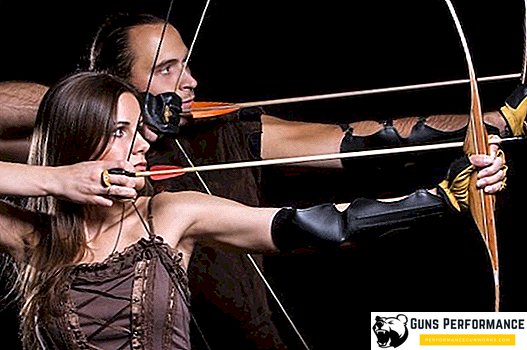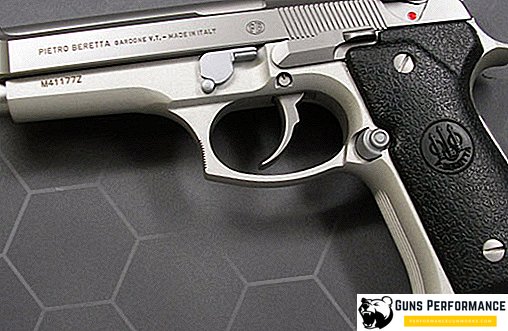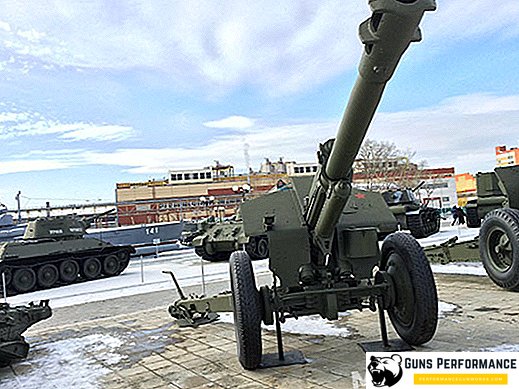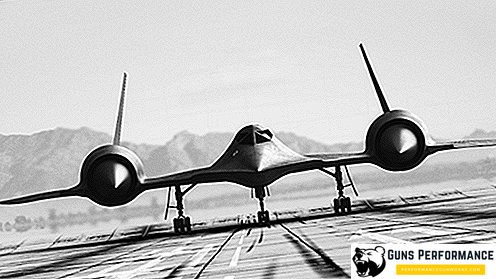
Few of us, looking at the sports bow in the hands of an athlete, think that this is one of the most ancient objects in everyday life of a person. Curious is the fact that the bow has retained its form and design to our times practically in the form in which it was used at the dawn of human civilization. The principle of operation of the weapon and its equipment remained intact. Only the scope has changed. The traditional bow has moved from the category of military and hunting weapons to the category of sports equipment and historical paraphernalia. Sports, hobbies and hunting are areas where the bow has retained its position. Today you can still find onions for hunting, which are used for limited purposes by hunters.
History is replete with a mass of facts and examples of how important this weapon occupied in human life. The hunting bow of the millennium served man as a reliable tool in search of prey for food. For thousands of years, a powerful war bow has remained perhaps the most progressive weapon on the battlefield. The first records in chronicles and chronicles of the combat use of onions refer to the period of the ancient Kingdom of Urartu (IX-VIII century BC). Later, already in the heyday of ancient Egypt, the bow firmly entered the arsenal of armies. Not a single battle of antiquity was complete without the participation of archers. These warriors became the prototype of modern rifle subunits. Massive archery of the enemy’s battle formations has become one of the main elements of military tactics in the history of wars.
From the era of Alexander the Great to the Battle of Azincourt, rifle bow was often the decisive factor influencing the outcome of battles. Even with the advent of firearms in service with armies, the bow continued to remain the main small arms for a long time. Only with the advent of armor and the subsequent improvement of firearms put an end to the combat use of the bow.
As for the use of weapons for hunting purposes, here the hunting bow continues to maintain its position. Some tribes of Central Africa, South America and Oceania still use these weapons as the main instrument of the struggle for food.

However, despite the new technologies and the emergence of the most advanced weapons, the bow has not lost its appeal. The person still has an interest in these weapons. The main reason for our attention to this ancient human companion is the simplicity and low cost of construction. Archery is one of those occupations that almost every healthy person can master. For a modern person, combat bow and the ability to shoot him have become a sport, pleasant entertainment and a hobby. There is something magical about this weapon. The ringing of a bowstring and the flight of an arrow act fascinatingly upon a person. Holding in his hands a stretched bow with an arrow, a person involuntarily feels like an archer, in which the primitive instincts of a hunter and a warrior awake.
Traditional bow and modernity

It should be said that with the advent of firearms, the bow has not disappeared from our sight. It can be said that the bow is experiencing its renaissance. The design of the weapon is significantly improved. Thanks to new technologies, the power of weapons has increased significantly. In addition to sports, bows for shooting are actively used by participants in historical reconstructions. Often there are models of this weapon on the shelves of hunting stores. However, sport remains the only area where the bow has firmly taken its place. Instead of a battlefield and hunting grounds, the bow received a residence permit at the shooting range. Archery, competition in the skill of possession of weapons has become one of the types of the Olympic program. For the first time, the bow became a sporting weapon at the 1900 Olympics held in Paris.
War bow and sport
Since 1972, sporting archery sports have become regular during the Summer Olympics. From that moment on, this sport began to grow rapidly. The emergence of new modifications of weapons and the relative availability of this sport contributed to the growing popularity. Attractively looked better sport for the younger generation. Children, having read adventure novels about Robin Hood, and brave knights with great pleasure, switched from children's fun to a serious passion for shooting. Children's onions became a springboard for big-time sports, where you could already improve your skills and achieve serious success. According to experts, the ability to shoot a bow has a beneficial effect on the development of a child, so it is not a secret to anyone that children's radiant sections are by far the most numerous.

The ability to shoot straight from the bow is not only the perfection of the physical condition of the child. Accuracy and shooting accuracy develop composure and endurance in a teenager. No wonder the archers in ancient times have always been famous for their endurance. It is difficult to survive and maintain composure when an enemy rider rushes at you at full speed. Keeping calm until the last moment and making sure an accurate shot is not an easy task. At first, the usual bent stick with a bowstring, and after a heavy block bow for competitions, become the weapon thanks to which children develop strength, dexterity, dexterity and patience.
Hunting bow - a tribute to fashion and an element of entertainment
As for hunting, it is important for this class to learn how to shoot straight and properly handle a bow. Hunting in modern conditions has little to ensure that successful fishing with the help of such weapons, which is the bow. Gone are the days when the game in nature was in sufficient quantities. A scared wild beast rarely allows a person to come close today, and accurate shooting at long distances can only be carried out with a firearm. Bows for hunting in modern conditions are ineffective and often useless weapons. As a rule, this method of hunting is used as entertainment.

In many ways, bow hunting resembles a historical reconstruction, which today is becoming one of the ways to spend leisure time. Despite the fact that modern models are significantly superior in combat characteristics to their ancestors, bows lose to hunting crossbows in accuracy and power.
Battle Bow and Story Link
A similar place in terms of entertainment takes bow, which is armed with members of historical clubs. During historical reconstructions of battles of medieval knights, the traditional bow is very popular. Not possessing large tactical and technical characteristics, such weapons play a demonstrative role. In this case, the main thing is not accuracy, but copying the combat use of the bow and imitating historical fact.
On the lists during the imitation of the historical battle can be found shooters, armed with huge, two-meter English bows. Their opponents can be swift horsemen from the Hun tribe, armed with curves and small war bows. For such hobbies, the main thing is to transfer the form of the weapon and show the public the basics of military tactics. There is no reason to speak of any high combat qualities of historical weapons.
What could be an onion?

We are all accustomed to the fact that the bow is a wooden stick, the ends of which are tied together with a string. This view is partly correct. The first prehistoric hunters were armed with just such weapons. Over time, the design of the bow changed, so later it was decided to divide them into three types:
- traditional shaped bows;
- classic or composite war bow;
- sports weapon or block bow.
Already in our time began to appear types of these weapons of non-standard design, such as spring-block and centrifugal recursive bows.
Traditional bows
Models of bows, which by form resemble historical weapons - are called traditional. This is the most common type of weapon. You can make it yourself or purchase a factory model. The construction in this case is the simplest and is not particularly complex. The main quality that a traditional bow should have is flexibility. The shoulders, the back, and the hilt were one whole piece made of wood. Usually for the manufacture of simple onions used branches of yew, ash, maple, stocks and walnut. The wood must be both firm and resilient at the same time. The selected wooden billet had to be soaked in water and after that keep it back up in a bent position for a certain time.

It is important to note that the weapons in the traditional form did not possess significant strength and, accordingly, did not possess great power. Hunting with a bow of this design could be successful. Such a bow had a maximum length of 100-140 cm. For hunting, more was not required, but for conducting combat operations a more powerful design was required. The first combat bows had a bowstring, made from the most accessible and common material in this region. It could be hemp fiber, dried and twisted tendons and animal intestines.
To the note: In the armies of antiquity, troops were followed by whole wagons carrying military equipment and weapons. The bulk of the rigging equipment consisted of blanks for combat bows, which during intensive hostilities often broke down.
Classic bow
War bow in the form in which we used to see it is a classic weapon. Its shape and design are already more perfect product. For the manufacture of such models requires specially selected wood, certain skills and craftsmanship. In contrast to the traditional bow - the classic weapon consisted of separate parts that complement each other and reinforce the entire structure.

Recalling the traditional form of children's onions, compound bows were much larger and, accordingly, had more power. For the first time the Arabs resorted to this design, experiencing a shortage of wood. For the manufacture of onions were taken two blanks from different types of wood. One piece had the necessary hardness, another piece added the necessary flexibility to the structure. The British brought the classic bow for perfection, creating the most terrible weapon of the Middle Ages. The two-meter compound bows of the British possessed such power that they could knock out a heavily armed warrior from a distance of 150-200 meters.
Classic bows in our time have evolved, becoming a sporting weapon. Bowstring for combat bow was made of woven linen or wool thread. Less often for equipping bows was horse and female hair. In the Middle Ages, the bowstring was made from rawhide, silk thread and hemp.
To the note: Children's bow, which often becomes a favorite toy of children, is usually equipped with a bowstring, woven from a strong kapron thread. The strength of the bowstring in this case does not play a role, whereas for a real weapon the elasticity of the bowstring must be balanced by the resistance force of the wooden part.
Modern sports bows are equipped with a bowstring made from synthetic materials, most often from lavsan or Kevlar.
A type of classic weapon was reinforced bow. A whalebone or sawn horn of an animal was added to the construction. These elements significantly increased the strength of the bow and improved its spring quality. Such innovations gave impetus to the appearance of composite bows, which came to us from the countries of the East. For a long time, hunting with onions, made by the new technology, remained the most widespread type of hunting.
The first such weapons were used by the Chinese. Short, with a span of only 70-80 cm, composite bows made of bamboo plates made it possible to fire at the same distance as bows with a span of up to 1 meter. Such weapons were usually included in the arsenal of the cavalry of the eastern armies. Composite bows became an analogue of modern block designs and were already far in their tactical and technical characteristics from their prototypes.
Sports and block bow
This weapon can be found today during sports. The time of wooden classic bows has passed. Current athletes are armed with powerful weapons, which are not a solid product, but a composite, spring design. Wood has long ceased to be used as the main material. Onion is a set of plates of fiberglass or carbon fiberglass.

The spring principle is that the bend of a thin plate in the composition of a type-setting construction has a small amount of compression and tension. The elasticity of the composite structure increases and the strength of the bow increases. Despite a significant and qualitative improvement in the manufacturability of weapons, archery sports modification requires certain skills and abilities. The base of the bow has become demanding to the skill of the shooter. In contrast to the classical and traditional weapons, the power of the bowstring tension increased by two. The firing range increased by 1.5-2 times. Due to the installation of sights on the base, the accuracy of the shot was significantly improved. The arrow is now placed in the plane of the bowstring, respectively, this reduces the beating of the projectile during movement.
It will take some effort to fire such weapons. So for adults it will be quite enough to make an effort of 12-14 kg. Teenagers and women will be enough effort to pull only 8-12 kg. Children can cope with archery, applying an effort of 5-7 kg, so it is not necessary for a child to buy children's onions for the first workouts. The usual sports bow weighing 10-12 kg. will be suitable for the first workouts.
Modern block bow is a steel structure, which came to us also from antiquity. Comparison and kinship, however, conditional, but the principle remains the same. The main feature of steel onions is a collapsible structure, which consists of blocks. The shoulders of the weapon were screwed to the handle. Such a weapon is highly accurate, but demanding to maintain and needs preparation for firing.
Conclusion
You can learn archery both independently and with a coach. It is not necessary to use expensive and heavy weapons for the first lessons. The classic bow is perfect for learning how to hit targets at a distance of up to 30-40 meters. Sports bows are a completely different type of weapon, which already requires a more serious attitude and approach. In any case, each of us can learn to own these weapons, both professionally and as an amateur.












